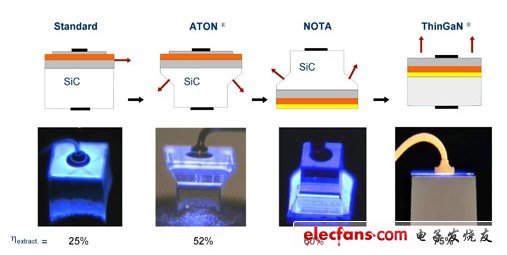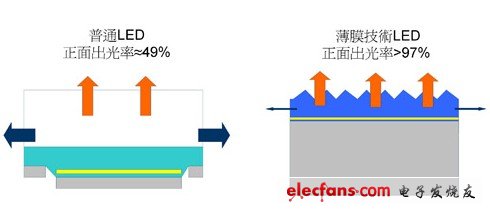Compared with traditional light sources such as incandescent lamps and compact fluorescent lamps, light-emitting diodes (LEDs) have many advantages such as high luminous efficiency, long life, and high directivity. They are increasingly favored by the industry and used in the general lighting market. To accelerate the popularity of LED lighting applications, there are still problems from the cost, technology, standards and other aspects that must be overcome in the short term. Technical aspects, including color temperature, color rendering and efficiency improvement, still need to be further improved. The application of LED in the general lighting market involves many requirements, which must be considered from the perspective of the system, such as LED light source, power conversion, drive control, heat dissipation and optics.
Thin-film chip technology is emerging
At present, the key to the development of LED chip technology lies in the base material and wafer growth technology. In addition to traditional sapphire materials, silicon (Si), silicon carbide (SiC), zinc oxide (ZnO) and gallium nitride (GaN) are also the focus of current research. Whether it is a high-power chip for key lighting and overall lighting, or a low-power chip for decorative lighting and some simple auxiliary lighting, the key to technological improvement is how to develop a more efficient and more stable chip. Therefore, improving the efficiency of LED chips has become the key to improving the overall technical indicators of LED lighting. In just a few years, with the help of a series of technical improvements such as chip structure, surface roughening, and multi-quantum well structure design, LED has made a major breakthrough in luminous efficiency. The development of LED chip structure is shown in Figure 1. It is believed that as the technology continues to mature, LED quantum efficiency will be further improved, and the luminous efficiency of LED chips will also rise.

Figure 1 Development history of LED chip structure
Thin film technology (Thinfilm) is a key technology for producing ultra-bright LED chips, which can reduce the lateral light loss. Through the bottom reflective surface, more than 97% of the light can be output from the front (Figure 2), which not only greatly improves the LED luminous efficiency, Also simple lens design.

Figure 2 Comparison of the frontal light extraction rate of ordinary LED and thin technology LED
Portable Heater Fan is ideal for use in an office or a small room. This heater is an automatic thermostat control with four positions for fan only, warm, hot, as well as off. The Heater Fan has a safety switch to shut off when tip over. It also has a thermal cut-off safety, a thermal fuse and a indicator light to let you know when it is working or not. This Fan Heater has two heat settings: 1000 and 2000 watts. When you just want to circulate some air, you can set it to cool fan only. or Keep warm when winter.
Portable Heater Fan, normal specialize as below:
- 2 heat settings (1000 and 2000 watts)
- Automatic thermostat control
- 4-position function switch (off, fan, warm and hot)
- Cooling Fan forced only setting
- Thermal fuse
- Thermal cut-off link
- Tip-over safety switch
- Power indicator light
Fenry have special portable fan heaters with 3 settings: 800W/1200W/2000W or 1200W/2400W with model number 809 series.
If you need, please contact us
thanks
Mainstays 2 In 1 Heater With Fan,Warmwave Space Heater,Portable Heater Blower,Portable Electric Fan Heater
Fenry manufacturing Co., Ltd , https://www.cnfenry.com